Analysis of Management Functions, Business Structure, and HR Practices
VerifiedAdded on 2022/12/30
|8
|2049
|52
Report
AI Summary
This report delves into the core concepts of management, exploring its functions and their impact on business operations. It begins with an introduction to management principles, emphasizing the efficient use of resources to achieve organizational goals. The report then examines various business functions, organizational structures (functional, hierarchical, and matrix), and their advantages and disadvantages. A significant portion is dedicated to marketing functions and their interconnections with other business units, such as operations and finance. The report also discusses Henry Fayol's five functions of management (planning, organizing, commanding, and controlling) and the relationship between planning and organizing. Furthermore, it analyzes the critical role of Human Resources (HR) in talent management, emphasizing employee motivation, skill development, and the creation of a positive organizational culture. The report concludes by summarizing the key findings and reinforcing the importance of effective management practices for business success.
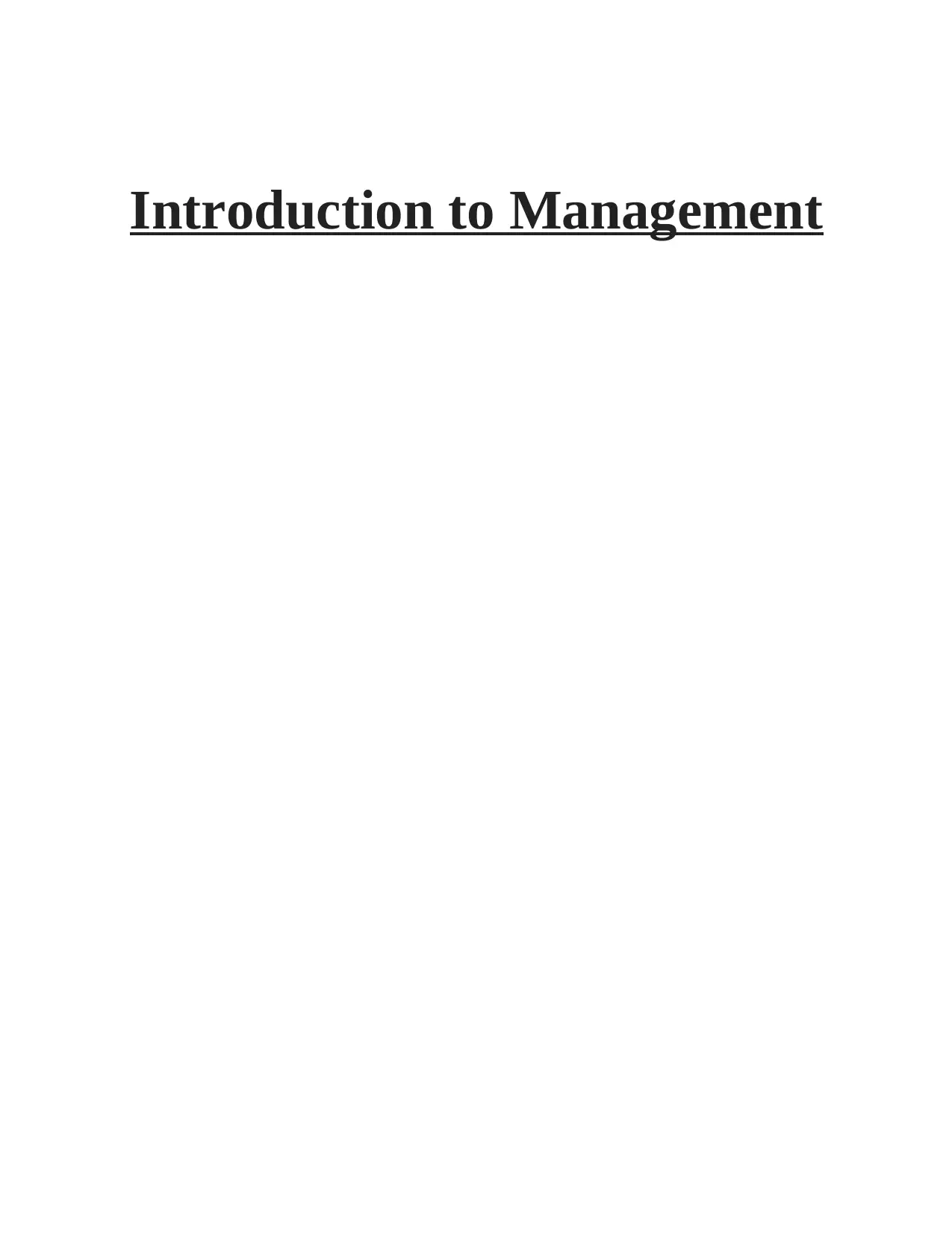
Introduction to Management
Paraphrase This Document
Need a fresh take? Get an instant paraphrase of this document with our AI Paraphraser
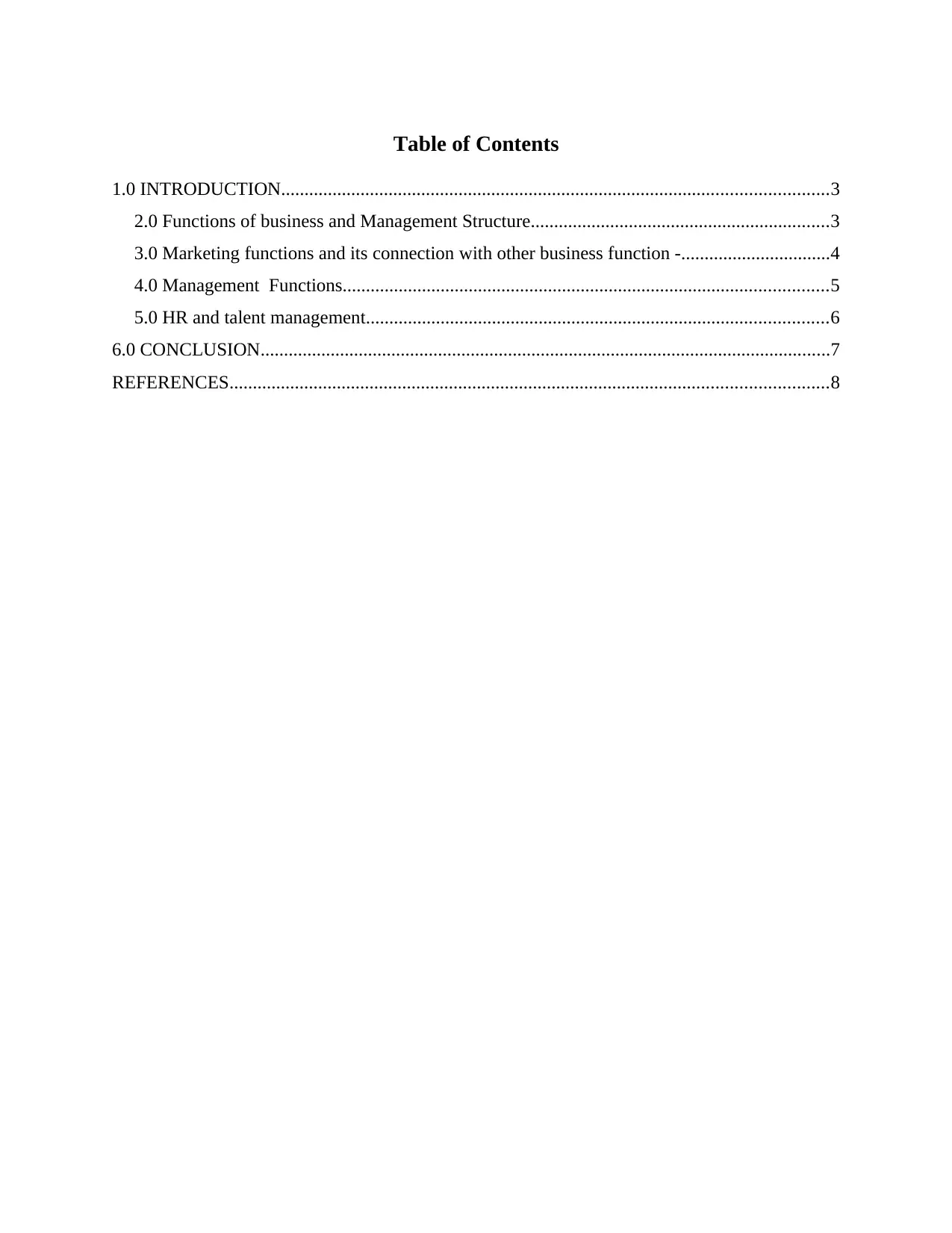
Table of Contents
1.0 INTRODUCTION.....................................................................................................................3
2.0 Functions of business and Management Structure................................................................3
3.0 Marketing functions and its connection with other business function -................................4
4.0 Management Functions........................................................................................................5
5.0 HR and talent management...................................................................................................6
6.0 CONCLUSION..........................................................................................................................7
REFERENCES................................................................................................................................8
1.0 INTRODUCTION.....................................................................................................................3
2.0 Functions of business and Management Structure................................................................3
3.0 Marketing functions and its connection with other business function -................................4
4.0 Management Functions........................................................................................................5
5.0 HR and talent management...................................................................................................6
6.0 CONCLUSION..........................................................................................................................7
REFERENCES................................................................................................................................8
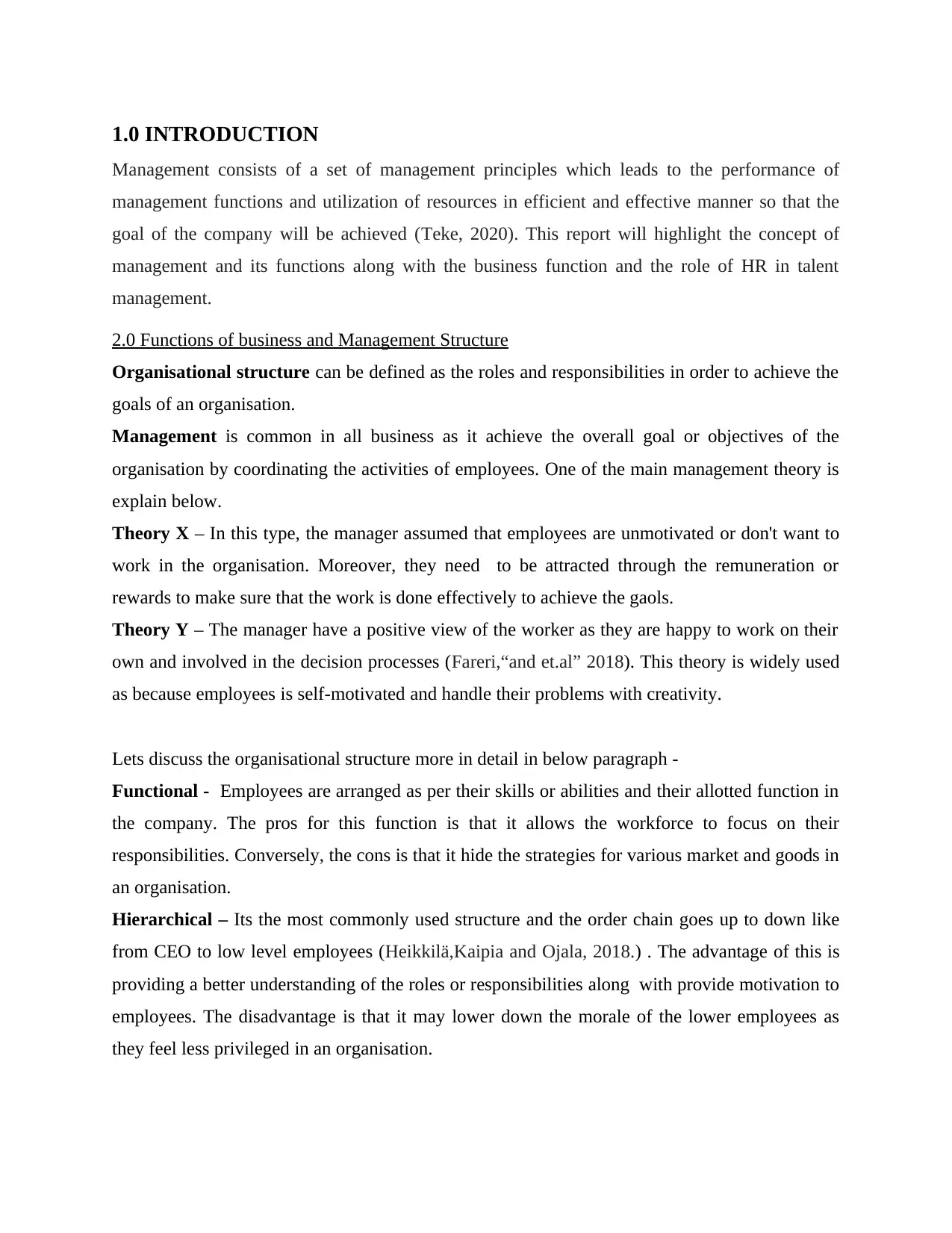
1.0 INTRODUCTION
Management consists of a set of management principles which leads to the performance of
management functions and utilization of resources in efficient and effective manner so that the
goal of the company will be achieved (Teke, 2020). This report will highlight the concept of
management and its functions along with the business function and the role of HR in talent
management.
2.0 Functions of business and Management Structure
Organisational structure can be defined as the roles and responsibilities in order to achieve the
goals of an organisation.
Management is common in all business as it achieve the overall goal or objectives of the
organisation by coordinating the activities of employees. One of the main management theory is
explain below.
Theory X – In this type, the manager assumed that employees are unmotivated or don't want to
work in the organisation. Moreover, they need to be attracted through the remuneration or
rewards to make sure that the work is done effectively to achieve the gaols.
Theory Y – The manager have a positive view of the worker as they are happy to work on their
own and involved in the decision processes (Fareri,“and et.al” 2018). This theory is widely used
as because employees is self-motivated and handle their problems with creativity.
Lets discuss the organisational structure more in detail in below paragraph -
Functional - Employees are arranged as per their skills or abilities and their allotted function in
the company. The pros for this function is that it allows the workforce to focus on their
responsibilities. Conversely, the cons is that it hide the strategies for various market and goods in
an organisation.
Hierarchical – Its the most commonly used structure and the order chain goes up to down like
from CEO to low level employees (Heikkilä,Kaipia and Ojala, 2018.) . The advantage of this is
providing a better understanding of the roles or responsibilities along with provide motivation to
employees. The disadvantage is that it may lower down the morale of the lower employees as
they feel less privileged in an organisation.
Management consists of a set of management principles which leads to the performance of
management functions and utilization of resources in efficient and effective manner so that the
goal of the company will be achieved (Teke, 2020). This report will highlight the concept of
management and its functions along with the business function and the role of HR in talent
management.
2.0 Functions of business and Management Structure
Organisational structure can be defined as the roles and responsibilities in order to achieve the
goals of an organisation.
Management is common in all business as it achieve the overall goal or objectives of the
organisation by coordinating the activities of employees. One of the main management theory is
explain below.
Theory X – In this type, the manager assumed that employees are unmotivated or don't want to
work in the organisation. Moreover, they need to be attracted through the remuneration or
rewards to make sure that the work is done effectively to achieve the gaols.
Theory Y – The manager have a positive view of the worker as they are happy to work on their
own and involved in the decision processes (Fareri,“and et.al” 2018). This theory is widely used
as because employees is self-motivated and handle their problems with creativity.
Lets discuss the organisational structure more in detail in below paragraph -
Functional - Employees are arranged as per their skills or abilities and their allotted function in
the company. The pros for this function is that it allows the workforce to focus on their
responsibilities. Conversely, the cons is that it hide the strategies for various market and goods in
an organisation.
Hierarchical – Its the most commonly used structure and the order chain goes up to down like
from CEO to low level employees (Heikkilä,Kaipia and Ojala, 2018.) . The advantage of this is
providing a better understanding of the roles or responsibilities along with provide motivation to
employees. The disadvantage is that it may lower down the morale of the lower employees as
they feel less privileged in an organisation.
⊘ This is a preview!⊘
Do you want full access?
Subscribe today to unlock all pages.

Trusted by 1+ million students worldwide
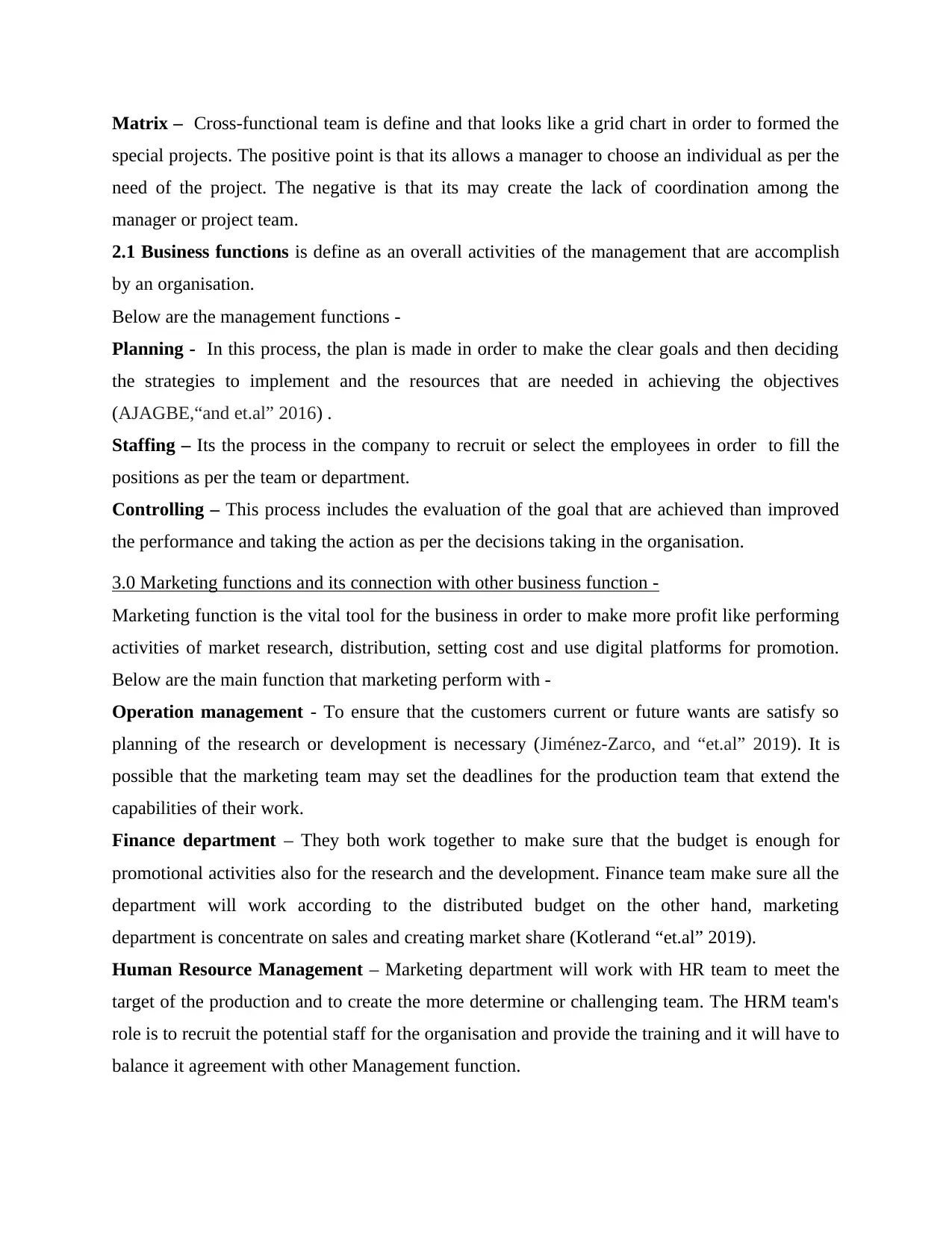
Matrix – Cross-functional team is define and that looks like a grid chart in order to formed the
special projects. The positive point is that its allows a manager to choose an individual as per the
need of the project. The negative is that its may create the lack of coordination among the
manager or project team.
2.1 Business functions is define as an overall activities of the management that are accomplish
by an organisation.
Below are the management functions -
Planning - In this process, the plan is made in order to make the clear goals and then deciding
the strategies to implement and the resources that are needed in achieving the objectives
(AJAGBE,“and et.al” 2016) .
Staffing – Its the process in the company to recruit or select the employees in order to fill the
positions as per the team or department.
Controlling – This process includes the evaluation of the goal that are achieved than improved
the performance and taking the action as per the decisions taking in the organisation.
3.0 Marketing functions and its connection with other business function -
Marketing function is the vital tool for the business in order to make more profit like performing
activities of market research, distribution, setting cost and use digital platforms for promotion.
Below are the main function that marketing perform with -
Operation management - To ensure that the customers current or future wants are satisfy so
planning of the research or development is necessary (Jiménez-Zarco, and “et.al” 2019). It is
possible that the marketing team may set the deadlines for the production team that extend the
capabilities of their work.
Finance department – They both work together to make sure that the budget is enough for
promotional activities also for the research and the development. Finance team make sure all the
department will work according to the distributed budget on the other hand, marketing
department is concentrate on sales and creating market share (Kotlerand “et.al” 2019).
Human Resource Management – Marketing department will work with HR team to meet the
target of the production and to create the more determine or challenging team. The HRM team's
role is to recruit the potential staff for the organisation and provide the training and it will have to
balance it agreement with other Management function.
special projects. The positive point is that its allows a manager to choose an individual as per the
need of the project. The negative is that its may create the lack of coordination among the
manager or project team.
2.1 Business functions is define as an overall activities of the management that are accomplish
by an organisation.
Below are the management functions -
Planning - In this process, the plan is made in order to make the clear goals and then deciding
the strategies to implement and the resources that are needed in achieving the objectives
(AJAGBE,“and et.al” 2016) .
Staffing – Its the process in the company to recruit or select the employees in order to fill the
positions as per the team or department.
Controlling – This process includes the evaluation of the goal that are achieved than improved
the performance and taking the action as per the decisions taking in the organisation.
3.0 Marketing functions and its connection with other business function -
Marketing function is the vital tool for the business in order to make more profit like performing
activities of market research, distribution, setting cost and use digital platforms for promotion.
Below are the main function that marketing perform with -
Operation management - To ensure that the customers current or future wants are satisfy so
planning of the research or development is necessary (Jiménez-Zarco, and “et.al” 2019). It is
possible that the marketing team may set the deadlines for the production team that extend the
capabilities of their work.
Finance department – They both work together to make sure that the budget is enough for
promotional activities also for the research and the development. Finance team make sure all the
department will work according to the distributed budget on the other hand, marketing
department is concentrate on sales and creating market share (Kotlerand “et.al” 2019).
Human Resource Management – Marketing department will work with HR team to meet the
target of the production and to create the more determine or challenging team. The HRM team's
role is to recruit the potential staff for the organisation and provide the training and it will have to
balance it agreement with other Management function.
Paraphrase This Document
Need a fresh take? Get an instant paraphrase of this document with our AI Paraphraser
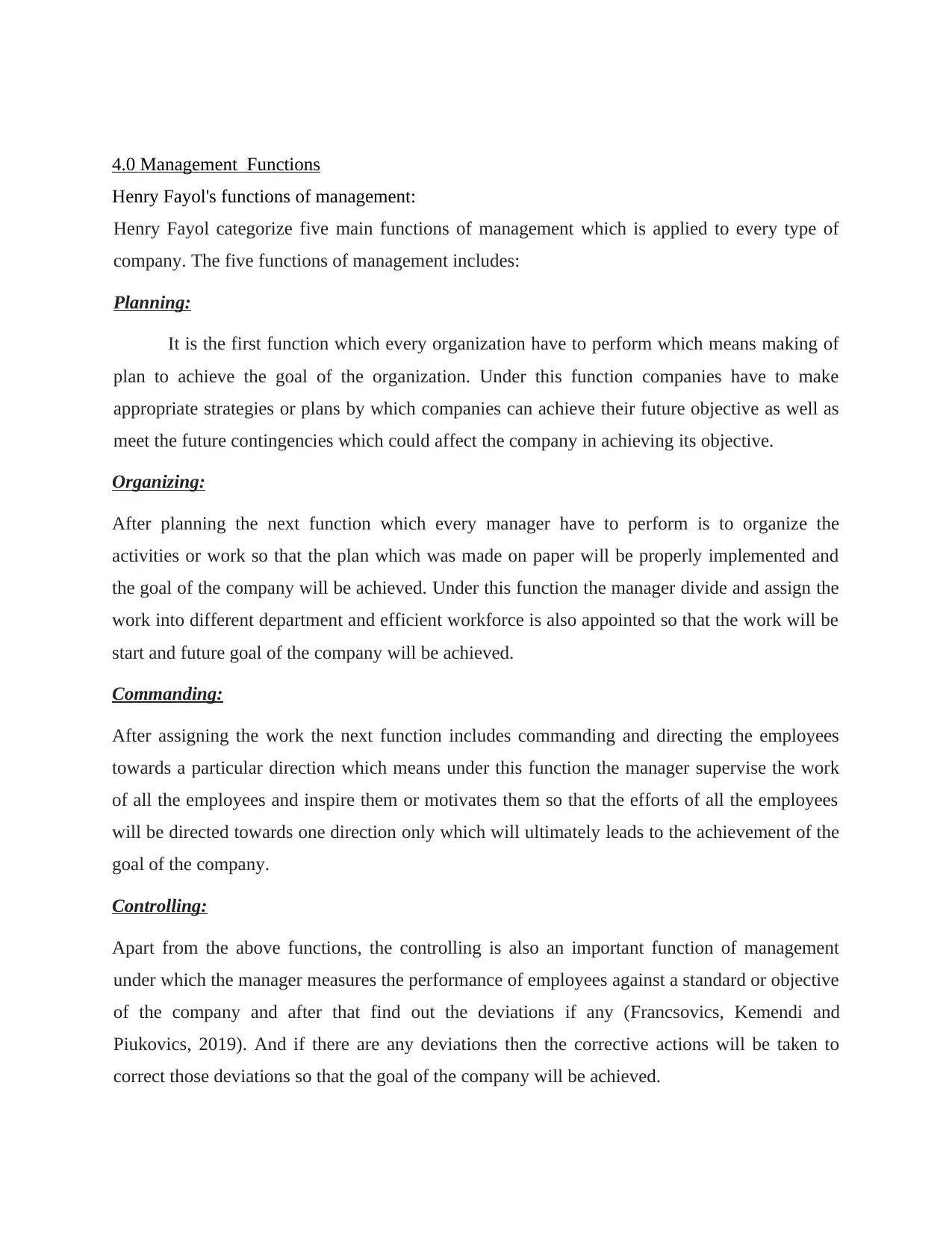
4.0 Management Functions
Henry Fayol's functions of management:
Henry Fayol categorize five main functions of management which is applied to every type of
company. The five functions of management includes:
Planning:
It is the first function which every organization have to perform which means making of
plan to achieve the goal of the organization. Under this function companies have to make
appropriate strategies or plans by which companies can achieve their future objective as well as
meet the future contingencies which could affect the company in achieving its objective.
Organizing:
After planning the next function which every manager have to perform is to organize the
activities or work so that the plan which was made on paper will be properly implemented and
the goal of the company will be achieved. Under this function the manager divide and assign the
work into different department and efficient workforce is also appointed so that the work will be
start and future goal of the company will be achieved.
Commanding:
After assigning the work the next function includes commanding and directing the employees
towards a particular direction which means under this function the manager supervise the work
of all the employees and inspire them or motivates them so that the efforts of all the employees
will be directed towards one direction only which will ultimately leads to the achievement of the
goal of the company.
Controlling:
Apart from the above functions, the controlling is also an important function of management
under which the manager measures the performance of employees against a standard or objective
of the company and after that find out the deviations if any (Francsovics, Kemendi and
Piukovics, 2019). And if there are any deviations then the corrective actions will be taken to
correct those deviations so that the goal of the company will be achieved.
Henry Fayol's functions of management:
Henry Fayol categorize five main functions of management which is applied to every type of
company. The five functions of management includes:
Planning:
It is the first function which every organization have to perform which means making of
plan to achieve the goal of the organization. Under this function companies have to make
appropriate strategies or plans by which companies can achieve their future objective as well as
meet the future contingencies which could affect the company in achieving its objective.
Organizing:
After planning the next function which every manager have to perform is to organize the
activities or work so that the plan which was made on paper will be properly implemented and
the goal of the company will be achieved. Under this function the manager divide and assign the
work into different department and efficient workforce is also appointed so that the work will be
start and future goal of the company will be achieved.
Commanding:
After assigning the work the next function includes commanding and directing the employees
towards a particular direction which means under this function the manager supervise the work
of all the employees and inspire them or motivates them so that the efforts of all the employees
will be directed towards one direction only which will ultimately leads to the achievement of the
goal of the company.
Controlling:
Apart from the above functions, the controlling is also an important function of management
under which the manager measures the performance of employees against a standard or objective
of the company and after that find out the deviations if any (Francsovics, Kemendi and
Piukovics, 2019). And if there are any deviations then the corrective actions will be taken to
correct those deviations so that the goal of the company will be achieved.
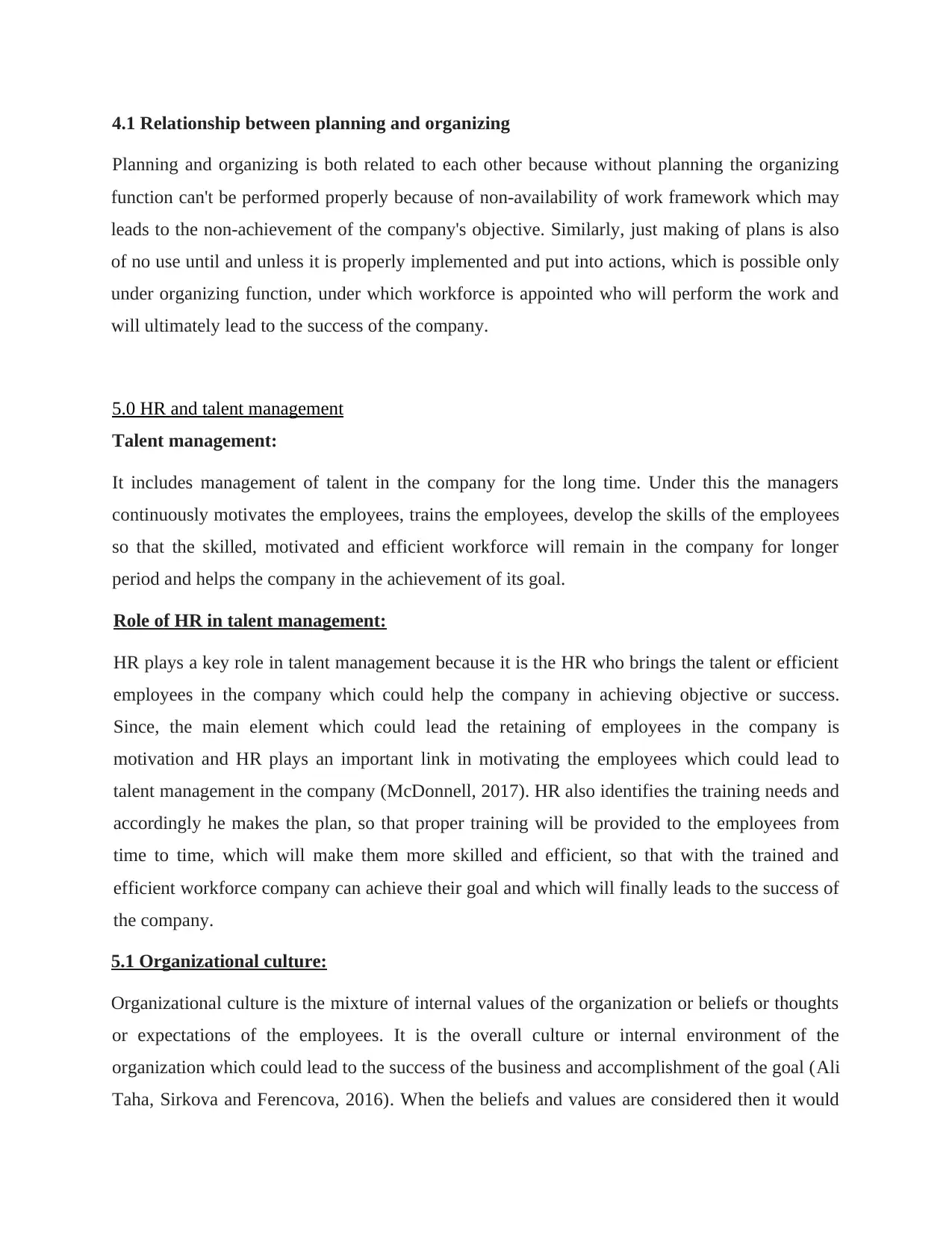
4.1 Relationship between planning and organizing
Planning and organizing is both related to each other because without planning the organizing
function can't be performed properly because of non-availability of work framework which may
leads to the non-achievement of the company's objective. Similarly, just making of plans is also
of no use until and unless it is properly implemented and put into actions, which is possible only
under organizing function, under which workforce is appointed who will perform the work and
will ultimately lead to the success of the company.
5.0 HR and talent management
Talent management:
It includes management of talent in the company for the long time. Under this the managers
continuously motivates the employees, trains the employees, develop the skills of the employees
so that the skilled, motivated and efficient workforce will remain in the company for longer
period and helps the company in the achievement of its goal.
Role of HR in talent management:
HR plays a key role in talent management because it is the HR who brings the talent or efficient
employees in the company which could help the company in achieving objective or success.
Since, the main element which could lead the retaining of employees in the company is
motivation and HR plays an important link in motivating the employees which could lead to
talent management in the company (McDonnell, 2017). HR also identifies the training needs and
accordingly he makes the plan, so that proper training will be provided to the employees from
time to time, which will make them more skilled and efficient, so that with the trained and
efficient workforce company can achieve their goal and which will finally leads to the success of
the company.
5.1 Organizational culture:
Organizational culture is the mixture of internal values of the organization or beliefs or thoughts
or expectations of the employees. It is the overall culture or internal environment of the
organization which could lead to the success of the business and accomplishment of the goal (Ali
Taha, Sirkova and Ferencova, 2016). When the beliefs and values are considered then it would
Planning and organizing is both related to each other because without planning the organizing
function can't be performed properly because of non-availability of work framework which may
leads to the non-achievement of the company's objective. Similarly, just making of plans is also
of no use until and unless it is properly implemented and put into actions, which is possible only
under organizing function, under which workforce is appointed who will perform the work and
will ultimately lead to the success of the company.
5.0 HR and talent management
Talent management:
It includes management of talent in the company for the long time. Under this the managers
continuously motivates the employees, trains the employees, develop the skills of the employees
so that the skilled, motivated and efficient workforce will remain in the company for longer
period and helps the company in the achievement of its goal.
Role of HR in talent management:
HR plays a key role in talent management because it is the HR who brings the talent or efficient
employees in the company which could help the company in achieving objective or success.
Since, the main element which could lead the retaining of employees in the company is
motivation and HR plays an important link in motivating the employees which could lead to
talent management in the company (McDonnell, 2017). HR also identifies the training needs and
accordingly he makes the plan, so that proper training will be provided to the employees from
time to time, which will make them more skilled and efficient, so that with the trained and
efficient workforce company can achieve their goal and which will finally leads to the success of
the company.
5.1 Organizational culture:
Organizational culture is the mixture of internal values of the organization or beliefs or thoughts
or expectations of the employees. It is the overall culture or internal environment of the
organization which could lead to the success of the business and accomplishment of the goal (Ali
Taha, Sirkova and Ferencova, 2016). When the beliefs and values are considered then it would
⊘ This is a preview!⊘
Do you want full access?
Subscribe today to unlock all pages.

Trusted by 1+ million students worldwide
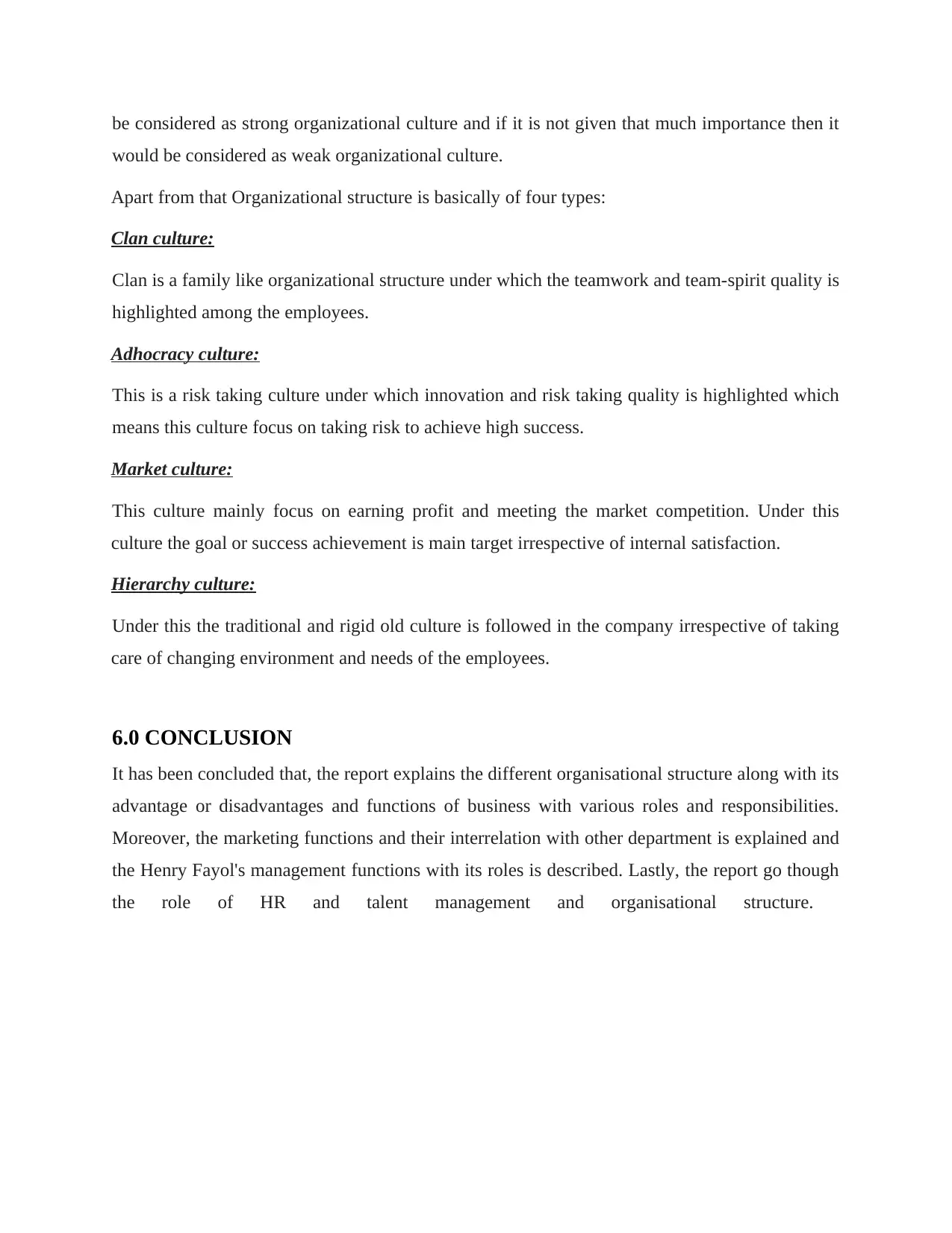
be considered as strong organizational culture and if it is not given that much importance then it
would be considered as weak organizational culture.
Apart from that Organizational structure is basically of four types:
Clan culture:
Clan is a family like organizational structure under which the teamwork and team-spirit quality is
highlighted among the employees.
Adhocracy culture:
This is a risk taking culture under which innovation and risk taking quality is highlighted which
means this culture focus on taking risk to achieve high success.
Market culture:
This culture mainly focus on earning profit and meeting the market competition. Under this
culture the goal or success achievement is main target irrespective of internal satisfaction.
Hierarchy culture:
Under this the traditional and rigid old culture is followed in the company irrespective of taking
care of changing environment and needs of the employees.
6.0 CONCLUSION
It has been concluded that, the report explains the different organisational structure along with its
advantage or disadvantages and functions of business with various roles and responsibilities.
Moreover, the marketing functions and their interrelation with other department is explained and
the Henry Fayol's management functions with its roles is described. Lastly, the report go though
the role of HR and talent management and organisational structure.
would be considered as weak organizational culture.
Apart from that Organizational structure is basically of four types:
Clan culture:
Clan is a family like organizational structure under which the teamwork and team-spirit quality is
highlighted among the employees.
Adhocracy culture:
This is a risk taking culture under which innovation and risk taking quality is highlighted which
means this culture focus on taking risk to achieve high success.
Market culture:
This culture mainly focus on earning profit and meeting the market competition. Under this
culture the goal or success achievement is main target irrespective of internal satisfaction.
Hierarchy culture:
Under this the traditional and rigid old culture is followed in the company irrespective of taking
care of changing environment and needs of the employees.
6.0 CONCLUSION
It has been concluded that, the report explains the different organisational structure along with its
advantage or disadvantages and functions of business with various roles and responsibilities.
Moreover, the marketing functions and their interrelation with other department is explained and
the Henry Fayol's management functions with its roles is described. Lastly, the report go though
the role of HR and talent management and organisational structure.
Paraphrase This Document
Need a fresh take? Get an instant paraphrase of this document with our AI Paraphraser
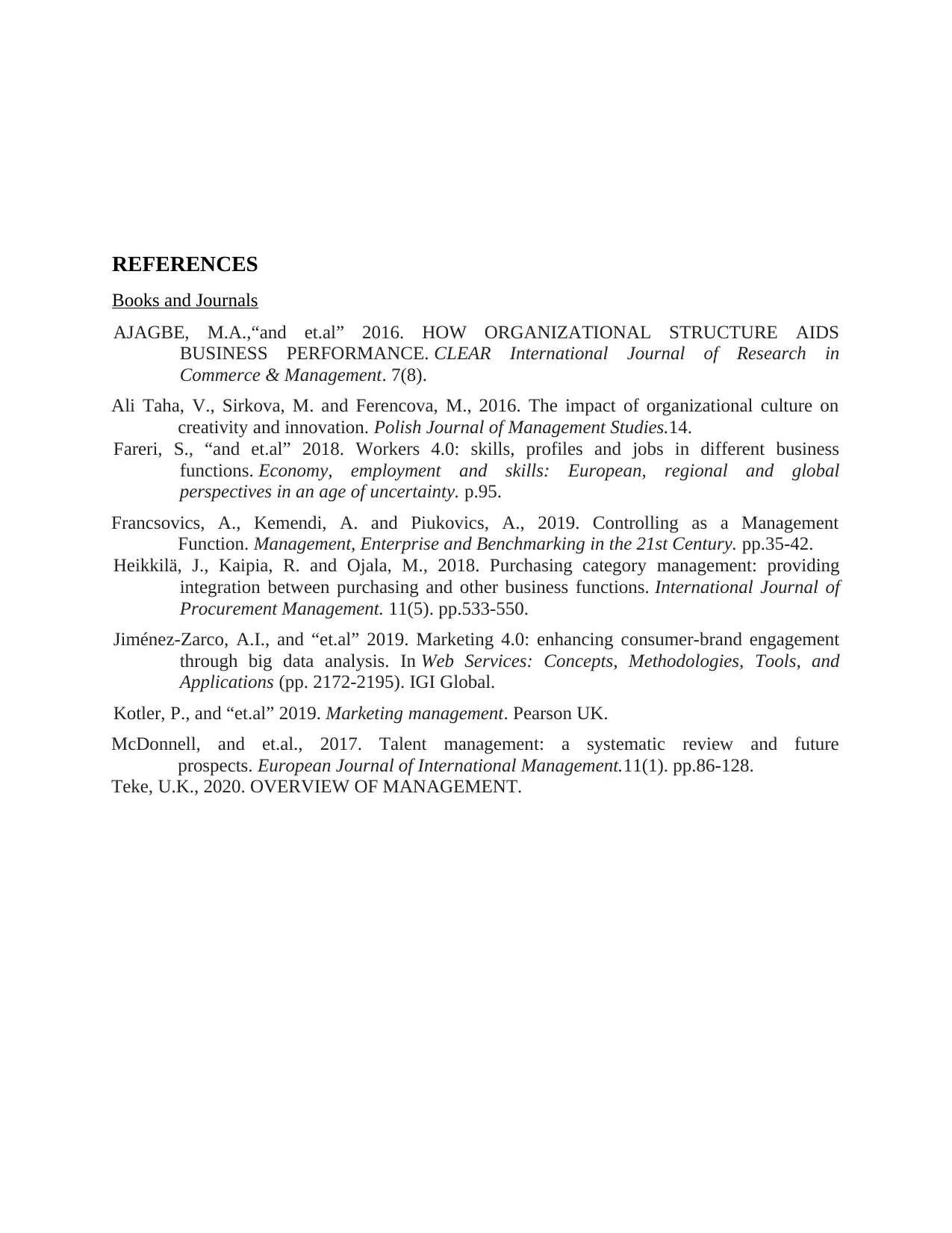
REFERENCES
Books and Journals
AJAGBE, M.A.,“and et.al” 2016. HOW ORGANIZATIONAL STRUCTURE AIDS
BUSINESS PERFORMANCE. CLEAR International Journal of Research in
Commerce & Management. 7(8).
Ali Taha, V., Sirkova, M. and Ferencova, M., 2016. The impact of organizational culture on
creativity and innovation. Polish Journal of Management Studies.14.
Fareri, S., “and et.al” 2018. Workers 4.0: skills, profiles and jobs in different business
functions. Economy, employment and skills: European, regional and global
perspectives in an age of uncertainty. p.95.
Francsovics, A., Kemendi, A. and Piukovics, A., 2019. Controlling as a Management
Function. Management, Enterprise and Benchmarking in the 21st Century. pp.35-42.
Heikkilä, J., Kaipia, R. and Ojala, M., 2018. Purchasing category management: providing
integration between purchasing and other business functions. International Journal of
Procurement Management. 11(5). pp.533-550.
Jiménez-Zarco, A.I., and “et.al” 2019. Marketing 4.0: enhancing consumer-brand engagement
through big data analysis. In Web Services: Concepts, Methodologies, Tools, and
Applications (pp. 2172-2195). IGI Global.
Kotler, P., and “et.al” 2019. Marketing management. Pearson UK.
McDonnell, and et.al., 2017. Talent management: a systematic review and future
prospects. European Journal of International Management.11(1). pp.86-128.
Teke, U.K., 2020. OVERVIEW OF MANAGEMENT.
Books and Journals
AJAGBE, M.A.,“and et.al” 2016. HOW ORGANIZATIONAL STRUCTURE AIDS
BUSINESS PERFORMANCE. CLEAR International Journal of Research in
Commerce & Management. 7(8).
Ali Taha, V., Sirkova, M. and Ferencova, M., 2016. The impact of organizational culture on
creativity and innovation. Polish Journal of Management Studies.14.
Fareri, S., “and et.al” 2018. Workers 4.0: skills, profiles and jobs in different business
functions. Economy, employment and skills: European, regional and global
perspectives in an age of uncertainty. p.95.
Francsovics, A., Kemendi, A. and Piukovics, A., 2019. Controlling as a Management
Function. Management, Enterprise and Benchmarking in the 21st Century. pp.35-42.
Heikkilä, J., Kaipia, R. and Ojala, M., 2018. Purchasing category management: providing
integration between purchasing and other business functions. International Journal of
Procurement Management. 11(5). pp.533-550.
Jiménez-Zarco, A.I., and “et.al” 2019. Marketing 4.0: enhancing consumer-brand engagement
through big data analysis. In Web Services: Concepts, Methodologies, Tools, and
Applications (pp. 2172-2195). IGI Global.
Kotler, P., and “et.al” 2019. Marketing management. Pearson UK.
McDonnell, and et.al., 2017. Talent management: a systematic review and future
prospects. European Journal of International Management.11(1). pp.86-128.
Teke, U.K., 2020. OVERVIEW OF MANAGEMENT.
1 out of 8
Related Documents
Your All-in-One AI-Powered Toolkit for Academic Success.
+13062052269
info@desklib.com
Available 24*7 on WhatsApp / Email
![[object Object]](/_next/static/media/star-bottom.7253800d.svg)
Unlock your academic potential
Copyright © 2020–2025 A2Z Services. All Rights Reserved. Developed and managed by ZUCOL.




